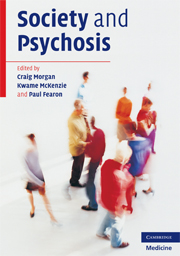Book contents
- Frontmatter
- Contents
- Contributors
- Acknowledgements
- 1 Introduction
- 2 Climate change in psychiatry: periodic fluctuations or terminal trend?
- Part I Theoretical and conceptual foundations
- Part II Social factors and the onset of psychosis
- 6 Society, place and space
- 7 Childhood adversity and psychosis
- 8 Family environment and psychosis
- 9 Adult adversity: do early environment and genotype create lasting vulnerabilities for adult social adversity in psychosis?
- 10 Migration, ethnicity and psychosis
- Part III Social factors and the outcome of psychosis
- Part IV Models and conclusions
- Index
- References
6 - Society, place and space
from Part II - Social factors and the onset of psychosis
Published online by Cambridge University Press: 07 December 2009
- Frontmatter
- Contents
- Contributors
- Acknowledgements
- 1 Introduction
- 2 Climate change in psychiatry: periodic fluctuations or terminal trend?
- Part I Theoretical and conceptual foundations
- Part II Social factors and the onset of psychosis
- 6 Society, place and space
- 7 Childhood adversity and psychosis
- 8 Family environment and psychosis
- 9 Adult adversity: do early environment and genotype create lasting vulnerabilities for adult social adversity in psychosis?
- 10 Migration, ethnicity and psychosis
- Part III Social factors and the outcome of psychosis
- Part IV Models and conclusions
- Index
- References
Summary
Introduction
This chapter will discuss the impact of society, place and space on the incidence of psychosis. It will briefly introduce the history of social causation theory before using the well established effect of urban residence on the incidence of psychosis in general, and schizophrenia in particular, as a lens through which to consider the possibilities for, and problems with, this research field. The reasons why the socioenvironmental context seems likely to be important will be described. Recent attention has focused on the idea that neighbourhood factors might exert an effect beyond their individual equivalents. For example, the social cohesion of a neighbourhood might have an effect on rates of psychosis above and beyond that of individual social networks. These possibilities, and the challenges associated with them, will be discussed.
History
Prior to the rise of modern medicine, the cause of disease was attributed to a variety of spiritual or mechanical factors, such as the elements, humours or miasma – bad air arising out of dirt and decaying organic matter. Early public health research, built on these theories, took the environment, in particular poor areas, to be aetiologically relevant. Risk was related to place; populations, rather than individuals, were considered more vulnerable because of where they lived rather than because of their own behaviour. Pioneers of public health in the mid-nineteenth century targeted sanitation of the slums, not education on personal hygiene, considering this to be the most important way of improving health (Porter, 1997, p. 411).
- Type
- Chapter
- Information
- Society and Psychosis , pp. 77 - 94Publisher: Cambridge University PressPrint publication year: 2008
References
- 7
- Cited by

